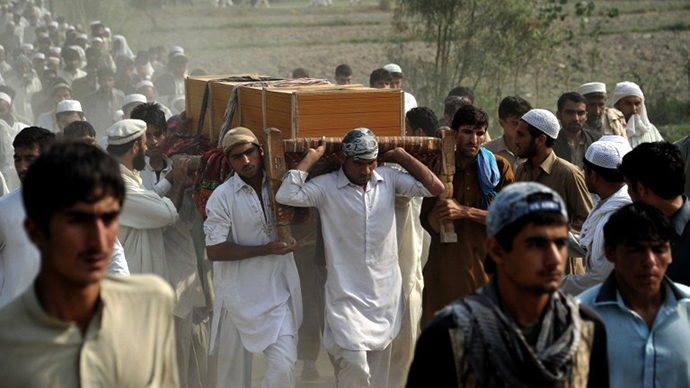By Azam Ahmed
KABUL, Afghanistan — Afghan officials said that a NATO airstrike in eastern Afghanistan killed a woman and two children on Tuesday, again raising the issue of civilian casualties at a time when both the presidential election and the future of the Western troop presence are unresolved.
Local officials said that a NATO aircraft had fired a rocket into a village in the Nadir Shah Kot district of Khost Province, striking an area where a family was gathered. In addition to killing the woman and children, the attack wounded a man, officials said. They said the victims may have been camping in tents in a mountainous part of the district.
A spokesman for the governor of Khost Province, Mubrez Zadran, said a delegation had been sent to the area to investigate.

Afghan men carry the coffin of a civilian, allegedly killed in a NATO air strike, on the outskirts of Jalalabad in Nangarhar province on October 5, 2013. (Photo: Noorullah Shirzada/AFP)
In the past, instances of NATO’s causing civilian casualties have led to harsh condemnations from President Hamid Karzai, and the issue helped derail the signing of a security pact between the Afghans and Americans after he demanded an end to all such attacks.
On Tuesday, Mr. Karzai condemned the attack as a “violation of agreements between the two countries” and ordered an investigation.
The American-led military coalition issued a statement saying that it was aware of the reports of civilian casualties, and that “we are looking into these allegations and will provide more information as available.”
The number of civilian deaths at the hands of coalition forces has been in rapid decline, in large part because conventional American troops rarely leave their bases anymore. Special Operations forces continue to conduct missions, typically alongside their Afghan counterparts, as advisers. On occasion, when overwhelmed by insurgent fire, they call in air support.
But even those airstrikes have grown rare, as coalition officials contend with an increasingly tough political landscape. Drone strikes have also contributed to civilian deaths, though the coalition says it scaled those back.
With Mr. Karzai set to leave office this year, and with the Americans preparing to withdraw most of their forces this year as well, the acrimony over Western military operations has only grown.
That tension reached a high point in January when a coalition airstrike in the Ghorband district of Parwan Province struck a village.
Neither side could agree on the death toll: The Afghans said at least 14 civilians died, while coalition officials put the number as low as two. The government of Mr. Karzai even issued a dossier of pictures and what it said was evidence of the strike, though some of that material was from an episode that occurred years earlier, and the authenticity of the rest remains under question.
It was unclear what might have led to the airstrike on Tuesday, and neither the coalition nor the Afghan government offered a description of the events preceding the attack. The area that was struck sits along a crucial highway connecting Khost and Paktia Provinces, though on a remote stretch of it. Government officials say that while the Taliban are active there, villagers also sometimes head up into the mountains to gather wood.
Farooq Jan Mangal contributed reporting.



